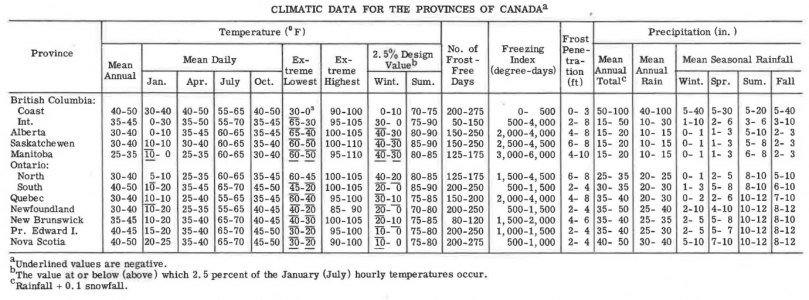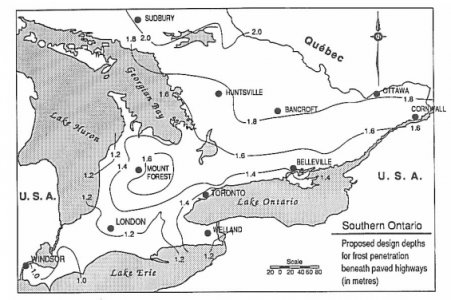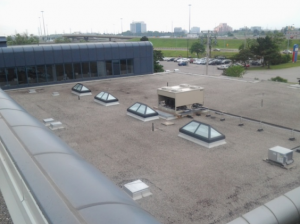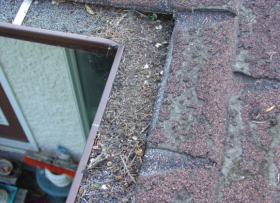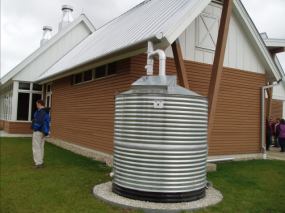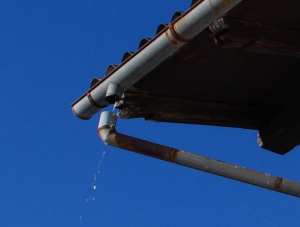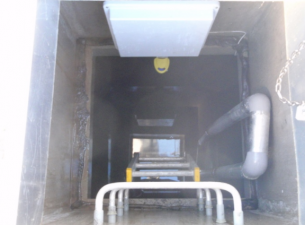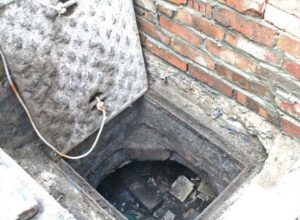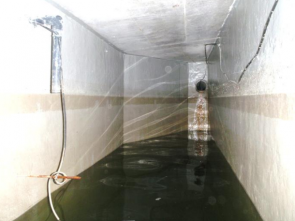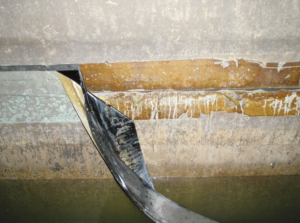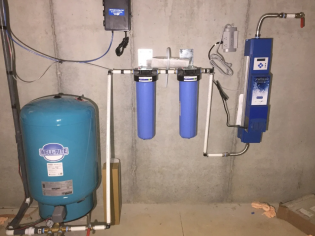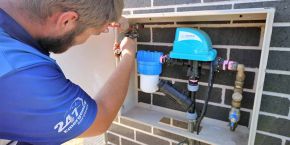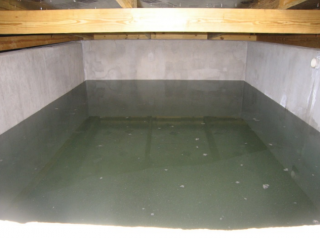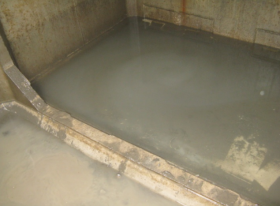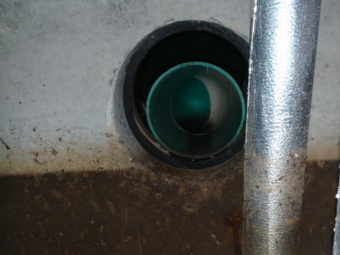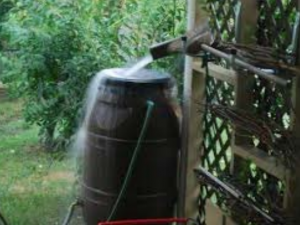Difference between revisions of "Inspection and Maintenance: Rainwater Harvesting"
| Line 215: | Line 215: | ||
*Remove natural debris and sediment annually to biannually; | *Remove natural debris and sediment annually to biannually; | ||
*Trim back tree boughs that hang over the roof area to reduce maintenance needs. | *Trim back tree boughs that hang over the roof area to reduce maintenance needs. | ||
|[[File:Pass.PNG|300px|thumb|center|CDA has not changed in size or land cover. Sediment, trash or debris is not accumulating and point sources of contaminants are not visible.]] | |[[File:CDA Pass RWH.PNG|300px|thumb|center|CDA has not changed in size or land cover. Sediment, trash or debris is not accumulating and point sources of contaminants are not visible.]] | ||
|[[File:Fail | |[[File:CDA Fail RWH.PNG|280px|thumb|center|Size of the CDA has changed from design assumptions. A point source for contaminants is visible (i.e. lack of sediment controls on adjacent construction site). (Photo Source: North Carolina Cooperative Extension)]] | ||
|- | |- | ||
|'''[[Pretreatment]]''' | |'''[[Pretreatment]]''' | ||
| Line 224: | Line 224: | ||
*Remove trash, debris and sediment biannually to quarterly or when the device sump is half full; | *Remove trash, debris and sediment biannually to quarterly or when the device sump is half full; | ||
*Measure sediment depth or volume during each cleaning, or annually to estimate accumulation rate and optimize frequency of maintenance. | *Measure sediment depth or volume during each cleaning, or annually to estimate accumulation rate and optimize frequency of maintenance. | ||
|[[File:Pretreatment | |[[File:Pretreatment Pass RWH.PNG|310px|thumb|center|[[Forebay]] is free of sediment, trash and debris and recently maintained. The large stones in the feature are used to slow down and spread out inflowing water into the feature and they remain well arranged and in place.]] | ||
|[[File:Pretreatment | |[[File:Pretreatment Fail RWH.PNG|290px|thumb|center|An erosion gully occurring where bare soil is starting to become visible on the [[Vegetated filter strips|grass filter strip]] pretreatment feature at the inlet, thus indicating it is not effectively slowing and spreading out the inflow of stormwater to the BMP.]] | ||
|- | |- | ||
|'''[[Inlets]]''' | |'''[[Inlets]]''' | ||
| Line 234: | Line 234: | ||
*For outdoor above-ground cisterns and rain barrels, inlets need to be disconnected in the late fall/early winter, prior to the onset of freezing air temperatures; | *For outdoor above-ground cisterns and rain barrels, inlets need to be disconnected in the late fall/early winter, prior to the onset of freezing air temperatures; | ||
*Reconnect outdoor above-ground cisterns to the roof drainage area in the spring once air temperature remains above freezing. | *Reconnect outdoor above-ground cisterns to the roof drainage area in the spring once air temperature remains above freezing. | ||
|[[File:Inlets | |[[File:Inlets Pass RWH.PNG|285px|thumb|center|There is no evidence of damage or displacement of the inlet structure that would prevent runoff from freely entering the BMP.]] | ||
|[[File:Inlets | |[[File:Inlets Fail RWH.PNG|300px|thumb|center|Accumulated sediment and vegetation is preventing stormwater from entering the BMP. Sediment on the pavement surface in front of the inlet indicates ponding is also occurring]] | ||
|- | |- | ||
|'''Access Hatch''' | |'''Access Hatch''' | ||
| Line 242: | Line 242: | ||
| | | | ||
*Inspect for damage, obstruction and accessibility annually. | *Inspect for damage, obstruction and accessibility annually. | ||
|[[File: | |[[File:Access Hatch Pass RWH.PNG|305px|thumb|center|The footprint area of the bioretention cell does not significantly deviate from the final design and should not negatively affect its stormwater management treatment performance.]] | ||
|[[File: | |[[File:Access Hatch Fail RWH.PNG|300px|thumb|center|The footprint area of the BMP is significantly smaller than what was specified in the final design of this example and differ greater than the recommended SWM criteria requirements (>10%).]] | ||
|- | |- | ||
|'''[[Rain barrels|Cistern or rain barrel]]''' | |'''[[Rain barrels|Cistern or rain barrel]]''' | ||
| Line 251: | Line 251: | ||
*Inspect for damage or leaking annually; | *Inspect for damage or leaking annually; | ||
*Drain and remove accumulated sediment as needed (annually at a minimum). | *Drain and remove accumulated sediment as needed (annually at a minimum). | ||
|[[File: | |[[File:Cistern Pass RWH.PNG|295px|thumb|center|There are no erosion gullies or bare soil areas on the filter bed surface and mulch cover remains in place.]] | ||
|[[File: | |[[File:Cistern Fail RWH.PNG|300px|thumb|center|Erosion gullies and bare soil areas are present on the filter bed surface, indicating that concentrated flow occurs regularly into the BMP feature. (Photo Source: CVC).]] | ||
|- | |- | ||
|'''[[Rainwater harvesting: Sizing and modeling#Cistern dimensions|Pump]]''' | |'''[[Rainwater harvesting: Sizing and modeling#Cistern dimensions|Pump]]''' | ||
| Line 259: | Line 259: | ||
| | | | ||
*Inspect and test for proper function annually. | *Inspect and test for proper function annually. | ||
|[[File: | |[[File:Pump Pass RWH.PNG|315px|thumb|center|The planted portion of the bioretention cell is completely covered with dense, attractive vegetation which helps to maintain its stormwater treatment function and aesthetic value.]] | ||
|[[File: | |[[File:Pump Fail RWH.jpg|290px|thumb|center|A larger portion of the bioretention cell has no vegetation cover which reduces its aesthetic value and could be negatively affecting its stormwater treatment function. Much less than 80% of the planting area is covered by living vegetation requiring immediate maintenance and reseeding.]] | ||
|- | |- | ||
|'''Filter''' | |'''Filter''' | ||
| Line 267: | Line 267: | ||
| | | | ||
*Remove debris and sediment biannually to quarterly or as directed by the system manufacturer. | *Remove debris and sediment biannually to quarterly or as directed by the system manufacturer. | ||
|[[File: | |[[File:Filter Pass RWH.PNG|320px|thumb|center|The overflow outlet is free of damage and obstruction and functions as originally designed.]] | ||
|[[File: | |[[File:Filter Fail RWH.PNG|280px|thumb|center|The overflow outlet is partially obstructed with trash and debris which reduces its capacity to safely convey excess water from the BMP, likely due to excess ponding thus obstructing outflow and impairing overall drainage function of the BMP.]] | ||
|- | |- | ||
|'''[[Overflow|Overflow Outlet]]''' | |'''[[Overflow|Overflow Outlet]]''' | ||
| Line 275: | Line 275: | ||
| | | | ||
*Check for [[clogging|obstructions]] and remove any debris or sediment annually to biannually. | *Check for [[clogging|obstructions]] and remove any debris or sediment annually to biannually. | ||
|[[File: | |[[File:Outlets Pass RWH.PNG|340px|thumb|center|The well is undamaged and accessible and the cap is in place and secured to prevent unauthorized access.]] | ||
|[[File: | |[[File:Outlets Fail RWH.PNG|300px|thumb|center|The well standpipe has been damaged by snow plowing, which impairs its use for monitoring and is a safety hazard. With the cap unable to be secured unauthorized access can also occur.]] | ||
|} | |} | ||
Revision as of 16:00, 15 August 2022
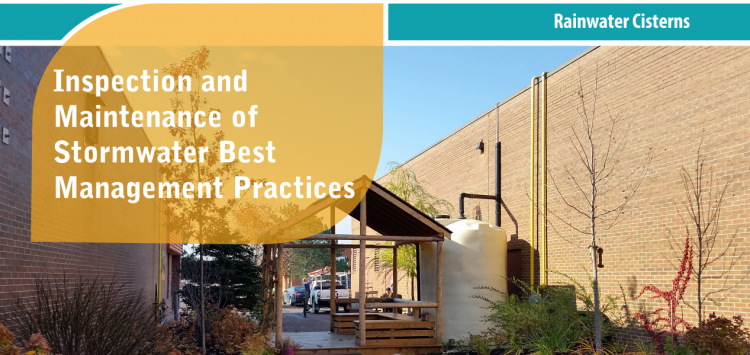
Overview[edit]
Rainwater harvesting/cisterns uses storage structures that can be installed either:
- Below-ground;
- Indoors that provide a year-round water source; or,
- Aboveground tanks and rain barrels that can only be used seasonally and must be taken out of service for the winter.
Rainwater cisterns can range in size from about 750 to 40,000 litres+ and may be constructed from fiberglass, plastic, metal or concrete.
Underground cisterns are most often installed to a depth below the maximum frost penetration depth (generally 1.2 m in Southern Ontario) (Armstrong and Csathy, 1963; Ministry of Transportation, 2013)[2][3] to ensure they can be used year-round. A pump is used to deliver the stored water to the hose bibs or fixtures where it is utilized. Water that is in excess of the storage capacity of the cistern overflows to an adjacent drainage system (e.g., other BMP or municipal storm sewer) via an overflow outlet structure and pipe. Cisterns that are drawn upon for indoor water uses (e.g., toilet flushing) will also feature water level sensors and the means of adding municipal water during extended periods of dry weather or winter when stormwater does not meet the demand (i.e., make-up water supply system). They may also include in-line devices to filter stored cistern water prior to delivery at hose bibs or fixtures.
Frost penetration in southern Ontario shown to be 2 - 4 ft. deep (Armstrong and Csathy, 1963)[4].
Design depth showing further detailed frost penetration contour lines for southern Ontario ranging from 1.0 - 2.0m deep (Ministry of Transportation, 2013)[5]
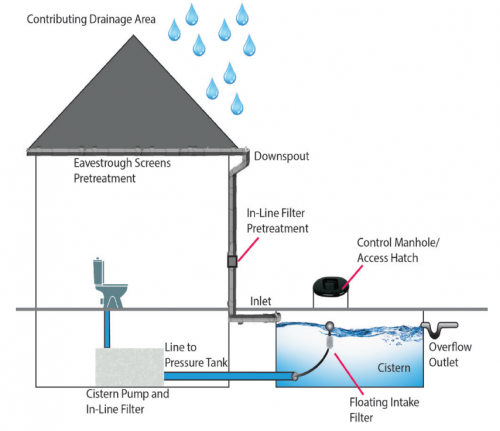
Some of the benefits of green roofs include:
- The ability to reduce the quantity of pollutants and runoff being discharged to municipal storm sewers and receiving waters (i.e., rivers, lakes and wetlands);
- Underground and indoor cisterns can be used year-round and located below parking lots, roads, plazas, parkland, landscaped areas or within buildings themselves.
- Can reduce a large commercial building or residential home's water usage significantly if used for non-potable needs
Key components of Underground Infiltration Systems to pay close attention to are the:
Associated Practices[edit]
- Rain Barrels Rain barrels are an above ground form of rainwater harvesting, typically used in residential settings. The precipitation flows from the roof, to the guttering and down the downspout before being diverted to the rain barrel for storage.
- Downspout disconnection Downspout disconnections are common in many older urban centers. They require that residents retroactively disconnect their downspouts from the municipal sewer system. This is due to older sewer systems being undersized for the combined flow of sanitary waste and stormwater.
- Blue roofs are systems that temporarily capture rainwater using the roof as storage and allow it to evaporate and/or to be used for non-potable requirements (i.e. irrigation, toilet flushing, truck washing) and ultimately offset potable water demands.
Inspection and Testing Framework[edit]
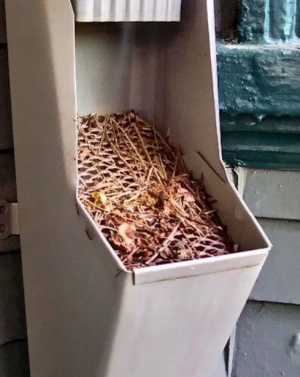
Component |
Indicators |
Construction Inspection |
Assumption Inspection |
Routine Operation Inspection |
Verification Inspection |
|---|---|---|---|---|---|
| Contributing Drainage Area | |||||
| CDA Condition | x | x | x | x | |
| Inlet | |||||
| Inlet/Flow spreader structural integrity | x | x | x | ||
| Inlet/Flow spreader obstruction | x | x | x | x | |
| Pretreatment sediment accumulation | x | x | x | ||
| Perimeter | |||||
| BMP dimensions | x | x | x | ||
| Overflow outlets | |||||
| Overflow outlet obstruction | x | x | x | x | |
| Control structure condition | x | x | x | x | |
| Cistern | |||||
| Cistern structural integrity | x | x | x | x | |
| Cistern sediment accumulation | x | x | x | x |
Component |
Indicators |
Construction Inspection |
Assumption Inspection |
Routine Operation Inspection |
Verification Inspection | |
|---|---|---|---|---|---|---|
| Testing Indicators | ||||||
| Sediment accumulation testing | x | x | x | x | ||
| Cistern pump testing | x | x | (x) | |||
| Note: (x) denotes indicators to be used for Performance Verification inspections only (i.e., not for Maintenance Verification inspections) | ||||||
Construction Inspection Tasks[edit]
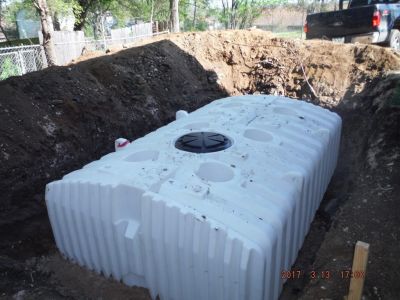
Construction inspections take place during several points in the construction sequence, specific to the type of LID BMP, but at a minimum should be done weekly and include the following:
- During site preparation, prior to BMP excavation and grading to ensure that adequate ESCs and flow diversion devices are in place and confirm that construction materials meet design specifications
- At completion of excavation and grading, prior to backfilling and installation of cistern and pipes to ensure depths, slopes and elevations are acceptable
- At completion of installation of cistern and pipes, prior to completion of backfilling to ensure slopes and elevations are acceptable
- Prior to hand-off points in the construction sequence when the contractor responsible for the work changes (i.e., hand-offs between the storm sewer servicing, paving, building and landscaping contractors)
- After every large storm event (e.g., 15 mm rainfall depth or greater) to ensure Erosion Sediment Controls (ESCs) and pretreatment or flow diversion devices are functioning and adequately maintained. View the table below, which describes critical points during the construction sequence when inspections should be performed prior to proceeding further. You can also download and print the table here
Construction Sequence Step & Timing |
Inspection Item |
Observations* |
|---|---|---|
| Site Preparation - after site clearing and grading, prior to BMP excavation and grading | Natural heritage system and tree protection areas remain fenced off | |
| ESCs protecting BMP layout area are installed properly | ||
| CDA is stabilized or runoff is diverted around BMP layout area | ||
| BMP layout area has been cleared and is staked/delineated | ||
| Benchmark elevation(s) are established nearby | ||
| Construction materials have been confirmed to meet design specifications | ||
| BMP Excavation and Grading - prior to backfilling and installation of cistern and conveyance pipes | Excavation location, footprint, depth and slopes are acceptable | |
| Installations of underdrains/sub-drain pipes (location, elevation, slope) are acceptable | ||
| BMP Installation – after installation of pipes/sewers, prior to backfilling | Installation of structural components (i.e., pretreatment devices, inlets, cistern, overflow outlet, pump, make-up water supply and backflow preventer valve, control manhole/ access hatch) are acceptable and functioning |
Routine Maintenance - Key Components and I&M Tasks[edit]
Regular inspections (twice annually, at a minimum) done as part of routine maintenance tasks over the operating phase of the BMP life cycle to determine if maintenance task frequencies are adequate and determine when rehabilitation or further investigations into BMP function are warranted.
Table below describes routine maintenance tasks for rainwater harvesting practices, organized by BMP component, along with recommended minimum frequencies. It also suggests higher frequencies for certain tasks that may be warranted for cisterns that receive flows from large roof drainage areas or roofs with mature trees near them. Tasks involving removal of debris, sediment and trash may need to be done more frequently in such contexts.
| Component | Description | Inspection & Maintenance Tasks | (Pass) Photo Example | (Fail) Photo Example |
|---|---|---|---|---|
| Contributing Drainage Area (CDA) |
Roof area(s) from which runoff directed to the BMP originates. |
|
||
| Pretreatment |
Devices prevent debris and sediment from entering the BMP. Includes eavestrough or downspout screens, first flush diverters or filters on pipes leading to or from the cistern. Reduce the risk of obstructing inlets, intakes or overflow outlet pipes and excessive sediment accumulation. |
|
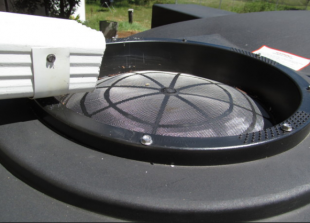 Forebay is free of sediment, trash and debris and recently maintained. The large stones in the feature are used to slow down and spread out inflowing water into the feature and they remain well arranged and in place. |
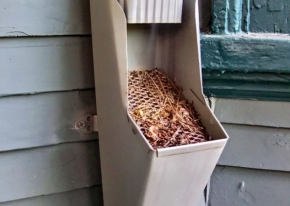 An erosion gully occurring where bare soil is starting to become visible on the grass filter strip pretreatment feature at the inlet, thus indicating it is not effectively slowing and spreading out the inflow of stormwater to the BMP. |
| Inlets |
Pipes connected to eavestroughs or roof drains that deliver water to the BMP. May also include a pipe connected to the municipal water supply line for maintaining cistern water level during dry weather. |
|
||
| Access Hatch |
Hatch, manhole or lid that provides access to the interior of the water storage structure. |
|
||
| Cistern or rain barrel |
The water storage structure (e.g., concrete vault, fiberglass, plastic or metal tank, rain barrel). |
|
||
| Pump |
Pressurized device used to deliver stored rainwater to the hose bibs. |
|
||
| Filter |
Cisterns may include an in-line filter device on the intake pipe or prior to delivery of rainwater to hose bibs. |
|
||
| Overflow Outlet |
Pipe connected to the cistern or rain barrel that conveys overflows to another drainage system (e.g., municipal storm sewer or other BMP). |
|
- ↑ 1.0 1.1 1.2 TRCA. 2018. Fact Sheet - Inspection and Maintenance of Stormwater Best Management Practices: Rainwater Cisterns. https://sustainabletechnologies.ca/app/uploads/2018/02/Rainwater-Cisterns-Fact-Sheet.pdf
- ↑ Armstrong, M. D., & Csathy, T. I. 1963. Frost design practice in Canada-and discussion. Ontario Department of Highways. https://onlinepubs.trb.org/Onlinepubs/hrr/1963/33/33-008.pdf
- ↑ Ministry of Transportation. 2013. Pavement Design and Rehabilitation Manual. Second Edition. IBSN: 978-1-4435-2873-3. Published: March 2013. http://www.bv.transports.gouv.qc.ca/mono/1165561.pdf
- ↑ Armstrong, M. D., & Csathy, T. I. 1963. Frost design practice in Canada-and discussion. Ontario Department of Highways. https://onlinepubs.trb.org/Onlinepubs/hrr/1963/33/33-008.pdf
- ↑ Ministry of Transportation. 2013. Pavement Design and Rehabilitation Manual. Second Edition. IBSN: 978-1-4435-2873-3. Published: March 2013. http://www.bv.transports.gouv.qc.ca/mono/1165561.pdf
- ↑ Innovative Water Solutions. 2021. Underground Polyethylene Cisterns - An Inexpensive Option for Buried Tanks. Accessed 08 August, 2022. https://www.watercache.com/portfolio/underground-poly-tanks
